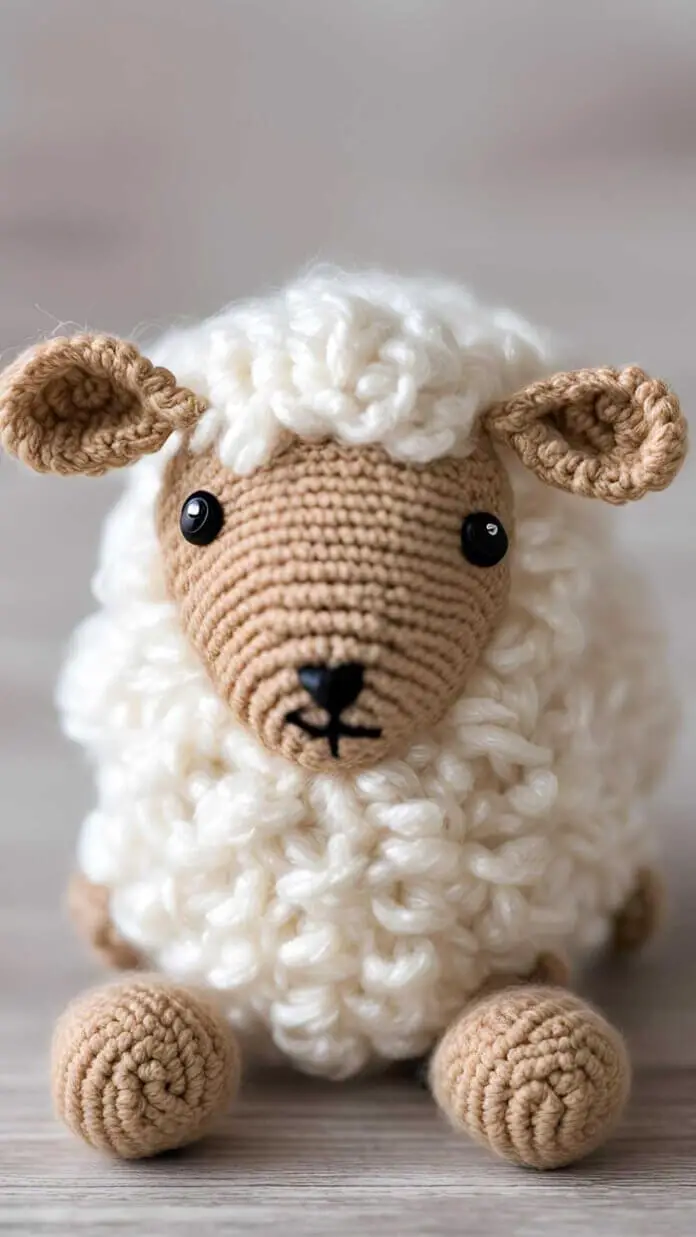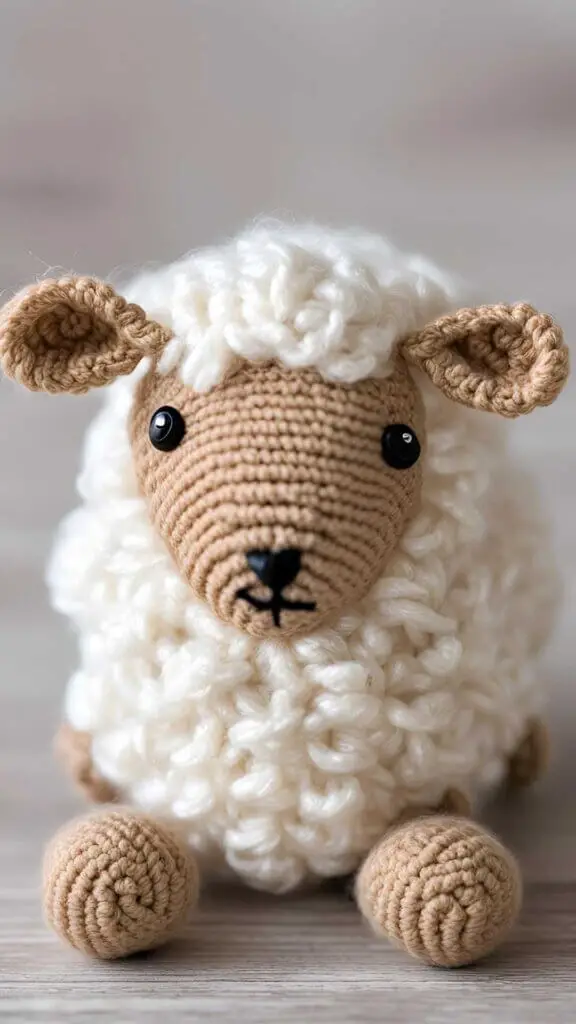Crocheting is a craft that combines creativity and skill to create various textiles and crafts, including crochet toys and home décor.
Whether someone is a beginner or looking to refine their technique, this guide covers the essentials of beginner crochet and crochet techniques.
It includes information about the materials needed, basic stitches, and different types of crochet patterns to inspire the next project.
Additionally, there is a step-by-step guide to making a crochet sheep, perfect for creating cute sheep designs and soft toys.
This guide provides a pathway to explore and develop crocheting skills, offering crochet tips and project ideas.
What Is Crocheting?
Crocheting is a versatile crafting technique that involves creating fabric by interlocking yarn or thread with a crochet hook. It is a popular form of DIY that enables enthusiasts to design a variety of items, ranging from clothing to home decor.
The art of crocheting has a history that spans centuries and has evolved over time, resulting in various patterns, including amigurumi, stuffed animals, and animal crochet like sheep amigurumi.
This engaging hobby attracts many individuals due to its creative possibilities, making it a preferred option for crafters and those interested in making handmade gifts and participating in the online crochet community.
What Are The Materials Needed For Crocheting?
To begin a crocheting journey, it is important to gather the necessary materials, as they significantly impact the outcome of projects.
The primary supplies needed include:
- Yarn, available in various weights and fibers, such as wool, cotton, and eco-friendly yarn
- A crochet hook that corresponds to the size of the chosen yarn
Additionally, having crafting supplies like scissors, stitch markers, and a yarn needle will facilitate the creation of crochet projects and enhance the experience for crochet enthusiasts.
What Are The Basic Stitches Used In Crocheting?
Understanding the basic crochet stitches is essential for anyone looking to begin their crochet journey, particularly beginners who want to master crochet techniques and explore free crochet patterns.
Key stitches, including chain stitch, slip stitch, single crochet, double crochet, half double crochet, and treble crochet, serve as the foundation for many crochet patterns.
Learning these stitches requires becoming familiar with crochet terminology and mastering different techniques, all of which contribute to creating beautiful designs and intricate projects.
1. Chain Stitch
The chain stitch is one of the most fundamental stitches in crocheting and often serves as the foundation for various crochet patterns. It is created by looping the yarn over the crochet hook and pulling it through the previous stitch, forming a chain-like structure that is essential for starting many crochet projects.
Understanding this basic technique can enhance a beginner’s skills and confidence in the craft. To create a proper chain stitch, one should start with a slip knot on the hook, ensuring it is snug yet movable.
Next, the yarn should be gently drawn through the slip knot, maintaining consistent tension to avoid uneven loops. Practicing a few chains is advisable to establish a rhythm, which will provide a solid base for more intricate stitches later on.
Mastering this stitch not only improves the aesthetic appeal of a project but also lays the groundwork for advanced techniques.
2. Slip Stitch
The slip stitch is a versatile and straightforward crochet stitch used for joining pieces, moving across the foundation chain, or finishing a project. This stitch enables crafters to transition smoothly from one stitch to another without adding height to the work.
Its simplicity appeals to both beginners and experienced crocheters. To perform a slip stitch, one typically inserts the hook into the desired stitch, yarns over, and pulls through both the stitch and the loop on the hook in a single motion. This technique is especially useful for joining different motifs in a blanket or for moving along the edges of a project without disrupting the established pattern.
When used in crochet patterns, the slip stitch can create delicate, decorative elements, making it an important tool for anyone looking to enhance their crochet skills.
3. Single Crochet
Single crochet is a foundational stitch in crocheting, recognized for its tight and sturdy fabric. This stitch is made by inserting the hook into a stitch, yarn over, pulling through, and completing the stitch with another yarn over.
Mastering this technique is important as it lays the groundwork for many intricate designs and patterns. It provides a strong base and is commonly used in various crochet projects, such as blankets, amigurumi, and garments, and pattern testing.
By understanding how to execute a single crochet stitch accurately, individuals can enhance their crochet skills and explore combining it with other basic crochet stitches, like half double or double crochet, making it a versatile option for crafters. Whether starting out or refining their techniques, the single crochet stitch remains a vital part of the crocheting process.
4. Double Crochet
Double crochet is a widely used stitch that creates a taller and more open fabric compared to single crochet, making it suitable for various patterns and designs. This stitch starts by yarning over before inserting the hook into a designated stitch, contributing to a more intricate appearance in crochet projects.
The flexibility of the double crochet stitch allows it to be easily incorporated into many crochet techniques, whether worked in rows for blankets or in rounds for hats. As crafters gain experience, they can combine this stitch with others, such as granny squares or shells, enhancing the texture and visual appeal of their projects.
The airy nature of double crochet makes it particularly well-suited for summer garments and lace shawls, making it a versatile option for those looking to enhance their work. Its straightforward technique encourages experimentation, leading to unique and personalized designs that reflect individual creativity.
5. Half Double Crochet
The half double crochet stitch combines elements of single and double crochet, resulting in a stitch that is taller than single crochet but shorter than double crochet. This stitch provides a unique texture and drape in crochet patterns, making it a popular choice for many projects.
Many crocheters appreciate how this stitch works well with both lightweight and heavier yarns, allowing for versatile applications in garments, blankets, and accessories. To create the half double crochet, one begins by yarn-over before inserting the hook into the designated stitch. This technique enhances the fabric’s depth and contributes to a more solid structure, making it suitable for various projects, from shawls to beanies.
Its versatility allows for easy integration with other crocheting techniques, offering a wide range of design possibilities.
6. Treble Crochet
Treble crochet is a stitch that adds height and texture to crochet projects, making it suitable for lacy designs and garments. This technique involves yarn over twice before inserting the hook into a stitch, which allows for the creation of intricate patterns.
Using treble crochet enhances the visual appeal of the work and provides flexibility for various projects. By incorporating this stitch into blankets, shawls, or accessories, crafters can achieve a lightweight, airy feel that is ideal for warmer weather. The stitch serves as a foundational element for creating detailed motifs and also acts as a bridging technique to connect different crochet methods seamlessly.
Understanding treble crochet opens the door to many creative possibilities, allowing artisans to experiment with different colors and textures in their designs.
What Is A Crochet Pattern?
A crochet pattern acts as a detailed guide that outlines the steps and techniques required to create a specific item. These patterns can vary from simple, free crochet instructions for beginners to more complex PDF patterns that include detailed instructions and pattern variations.
Being able to read and follow these patterns is essential for successful crocheting, and crochet classes can enhance this skill.
What Are The Different Types Of Crochet Patterns?
Crochet patterns are available in various formats, catering to the preferences and skill levels of crocheters. The main types include free resources and online tutorials, among others:
- written patterns, which offer detailed instructions;
- chart patterns, which use visual representations;
- video tutorials, which provide step-by-step guidance for those who learn visually, often found on crochet blogs and forums.
1. Written Patterns
Written crochet patterns are detailed documents that guide crafters through the process of creating specific items, providing clear instructions for each step. They often include abbreviations and crochet terminology, making them accessible for various skill levels.
Understanding these abbreviations and terms is crucial for successful pattern navigation, as it allows crocheters to interpret and execute the instructions accurately. By familiarizing themselves with common crochet symbols and shorthand, users can enhance their crafting experience and share patterns more effectively within the community.
This understanding not only streamlines the creation process but also gives individuals the power to customize existing designs or craft original pieces, encompassing everything from amigurumi sheep to seasonal crafts, thereby expanding their crochet repertoire. Ultimately, well-structured patterns serve as a bridge for crafters, fostering creativity and connection among those who share a passion for yarn and artistry and engage in social crafting.
2. Chart Patterns
Chart patterns provide a visual representation of crochet stitches and techniques, making them a valuable resource for visual learners. These patterns utilize symbols and grids to illustrate the design, allowing for quick reference during crocheting, whether you’re crafting soft toys or home décor.
By becoming familiar with the various symbols and their corresponding stitches, crocheters can easily navigate through these diagrams. Understanding chart patterns helps in grasping the overall flow and structure of a project, ultimately enhancing the crocheter’s skill set. They indicate not only the necessary stitches but also the modifications and repeats involved, which are essential for creating complex designs.
Utilizing these visual crochet patterns can significantly improve one’s ability to interpret and create unique projects, opening the door to a wide range of creative possibilities.
3. Video Tutorials
Video tutorials have gained popularity among crochet enthusiasts, offering step-by-step guidance that is visually engaging. These crochet videos often complement written or chart patterns, enhancing the learning experience by demonstrating techniques in real-time, including crochet techniques and crochet instructions.
This format allows crocheters to better understand the intricacies of stitches and techniques that may be difficult to interpret through text alone. By observing an experienced crocheter work through a pattern, learners can gain clarity on aspects such as tension, hook movement, and yarn manipulation.
Additionally, video tutorials can be paused and replayed, providing flexibility that traditional pattern reading lacks. Consequently, these instructional videos serve as a valuable supplement, helping crocheters build confidence as they tackle more complex designs and create intricate pieces.
What Are The Benefits Of Using A Crochet Pattern?
Using crochet patterns provides various benefits that can enhance the crafting experience. Firstly, following a crochet pattern ensures accuracy in stitch count and design, helping individuals achieve their desired outcome, whether working on a crochet project or crafting DIY crochet items.
Additionally, patterns offer inspiration and creative ideas for future projects, contributing to the development of the crocheter’s skill set.
1. Ensures Accuracy
One of the key advantages of using a crochet pattern is that it ensures accuracy in the work. By following the pattern instructions, crafters can maintain a consistent stitch count and achieve the correct dimensions for their projects.
This precision impacts not only the aesthetics of the final product but also the overall durability and fit of the crocheted item. When a crochet enthusiast follows a specific pattern, they have the opportunity to create pieces that are both visually appealing and designed to last.
Understanding the nuances of pattern terminology, gauge, and stitch techniques is essential for translating the designer’s vision into a successful outcome. As crafters work through these patterns, they may discover that small deviations can lead to significant variations, highlighting the importance of accuracy for producing a polished and satisfying finish.
2. Saves Time
Following a crochet pattern can save time by providing a clear roadmap for efficiently completing a project. Instead of making decisions on the go, crocheters can focus on executing the pattern, which streamlines the crafting process.
By reducing the time spent figuring out stitches or colors, crocheters can fully engage in the enjoyment of the craft. With this increased efficiency, many find they can take on multiple projects in a shorter timeframe, allowing them to explore a variety of crochet patterns and styles. This not only enhances creativity but also results in a sense of accomplishment with completed works that can be gifted or displayed.
Ultimately, the time saved through effective planning fosters a greater appreciation for the art, allowing for more relaxed crochet sessions rather than rushed attempts, making each stitch more enjoyable.
3. Provides Inspiration
Crochet patterns provide a source of inspiration, encouraging crafters to explore new techniques, styles, and designs. They can ignite creativity and lead to original projects that reflect the crocheter’s personality and interests.
By engaging in various crochet projects, enthusiasts can discover unique color combinations, stitch varieties, and even unexpected motifs that expand their artistic boundaries. As they experiment, each crafted piece transforms from a simple pattern into a personalized expression of their vision and skill development. This creative journey not only enhances their repertoire but also fosters a sense of confidence that encourages further exploration in their hobbies.
With each twist of the yarn and movement of the hook, crafters have the opportunity to create something truly original, adding depth to their artistic journey.
How To Find Free Crochet Patterns?
Finding free crochet patterns is more accessible now, thanks to the numerous online resources and the supportive crochet community.
Various websites, blogs, and social media platforms provide free tutorials and downloadable patterns that cater to all skill levels and project types.
1. Online Sources
The internet offers a wide variety of free crochet patterns, with numerous online sources available for crafters. Many crochet blogs and websites provide downloadable patterns in PDF format, making it convenient to begin new projects, including amigurumi patterns and pattern variations.
Popular platforms include Ravelry, LoveCrafts, and Yarnspirations, each featuring extensive libraries of user-friendly and creative designs. Reputable blogs such as Moogly and AllFreeCrochet serve as reliable resources, offering patterns along with instructional videos and tips to improve skills.
By utilizing established websites, users can ensure quality and clarity in their projects, reducing the likelihood of frustration and unsatisfactory results. Exploring these platforms can foster creativity and connect crafters with a community that shares a passion for crochet.
2. Local Libraries and Craft Stores
Local libraries and craft stores serve as valuable resources for finding free crochet patterns, often offering books and pamphlets that showcase a variety of designs. Many craft stores provide free patterns with the purchase of materials, encouraging crafters to explore new projects.
Plus these physical resources, participating in local events and workshops can enhance the crafting experience. Community gatherings often create opportunities to connect with other enthusiasts who share insights and tips, making the learning process more enjoyable.
During workshops, attendees may gain access to unique patterns and techniques demonstrated by experienced crocheters. Libraries often host craft nights or classes where participants can learn directly from experts, fostering a sense of community and creativity.
Utilizing these community resources not only improves crafting skills but also helps build lasting friendships among crafters.
How To Follow A Crochet Pattern?
Learning to follow a crochet pattern is important for successful crafting, as it requires understanding the crochet instructions and techniques provided, especially for easy crochet patterns and pattern testing.
This process involves reading the pattern carefully, gathering the necessary materials, and systematically executing each step.
1. Read The Pattern Carefully
The first step in successfully following a crochet pattern is to read it carefully, ensuring an understanding of all components, including stitch abbreviations and special techniques. Taking the time to comprehend the pattern can help prevent mistakes and enhance the overall crafting experience.
By familiarizing oneself with the terminology and instructions, a crocheter can navigate through the intricacies of the design more effectively, leading to a more enjoyable and satisfying project. Understanding the meaning behind each term, whether it’s a slip stitch or a double crochet, provides a solid foundation for all subsequent steps.
Recognizing the symbols or diagrams often included with yarn patterns can also improve the ability to visualize the end result. This preparatory work not only boosts confidence but also assists in troubleshooting any issues that may arise during the crocheting process.
2. Gather All Materials
Before starting a crochet project, it is important to gather all necessary materials, including yarn, crochet hooks, and other crafting tools. This includes considering yarn weight, eco-friendly yarn, and organizing crochet supplies. Having everything prepared in advance leads to a smoother crafting experience and reduces interruptions during the process.
Taking the time to organize crochet supplies enhances efficiency and creates a more enjoyable environment for creativity. Consider sorting yarn by color, weight, or fiber content, and keeping crochet hooks organized in a convenient case for easy access.
By ensuring that crafting tools and crafting supplies are within reach, individuals can fully engage in their DIY crochet projects, allowing their artistic vision to develop without interruption. This planning phase is not only about preparation; it sets the foundation for a rewarding crafting journey that can lead to beautiful, handmade creations.
3. Follow The Instructions Step-by-Step
Following the crochet instructions step-by-step is essential for successfully completing a crochet project. Each stitch and technique serves a purpose within the crochet pattern, and sticking to the outlined steps ensures a favorable outcome.
Taking the time to carefully follow these instructions not only improves the quality of the final piece but also enhances overall crochet skills. Working methodically allows for a better understanding of crochet techniques, such as maintaining tension and creating consistent stitches, which are important for achieving a polished look.
When challenges arise, like a missed stitch or a complex pattern, a systematic approach helps crocheters identify and resolve mistakes more easily. By closely following each part of the process, individuals build confidence in their abilities, leading to more intricate and rewarding projects.
How To Make A Crochet Sheep?
Creating a crochet sheep is a rewarding project suitable for both beginners and experienced crocheters. This amigurumi sheep project encourages creative expression, offering a variety of free crochet sheep patterns and pattern downloads that cater to different skill levels and styles.
By following the provided pattern instructions and engaging with crochet tutorials, crafters can make a charming stuffed animal that brings joy to both the maker and its future owner.
1. Gather Materials
To begin making a crochet sheep, it is important to gather all the necessary materials, which include wool yarn, a crochet hook, stuffing, and any desired embellishments. Choosing the right yarn weight and color options is essential for achieving the intended look and feel of the stuffed animal.
In this process, selecting a soft, bulky yarn can create a plush texture that is suitable for a cuddly sheep. A size H-8 (5mm) crochet hook is typically recommended for working with this thicker yarn, ensuring the stitches are tight enough to securely hold the stuffing. Synthetic stuffing material will provide shape and volume to the finished product. For added character, one might consider embellishing with safety eyes or a decorative bow, reflecting creative crafts techniques.
Having a yarn needle for sewing pieces together can also simplify the crafting process, providing the finished sheep with a polished appearance, perfect for handmade gifts and home décor.
2. Start With The Body
The first step in creating a crochet sheep is to begin with the body, which serves as the foundation for the entire stuffed animal. By following the pattern instructions, crocheters can construct a solid base that will support the rest of the sheep’s features.
This initial phase is important, as it determines the shape and stability of the finished product. Attention to detail is essential; even small deviations can lead to significant differences in the overall appearance. Using appropriate yarn and a suitable hook size will help achieve the right tension and size as specified in the crochet instructions.
As each stitch is worked through, whether it’s single crochet or increases, it is helpful to envision how the completed sheep will take shape. Staying focused on the pattern will ensure accuracy and enhance the overall experience of this amigurumi project.
3. Create The Legs
Next, crocheters will create the legs of the sheep, which contribute to its stability and overall design. Each leg is crafted separately, allowing for attention to detail and customization in the final amigurumi sheep design.
To start, choose a yarn color that complements the body and gather the appropriate crochet hook for your yarn weight. Begin by casting on a magic ring and working through increases to shape the leg. As you progress, you can use varying stitch patterns to add texture or incorporate contrasting yarn for highlights to enhance visual appeal.
Remember that adjusting the leg length can add personality, ensuring creativity shines through in each completed sheep. It is also important to stuff each leg lightly before finishing to achieve the plump, cuddly feel that amigurumi enthusiasts appreciate.
4. Make The Head And Ears
After completing the legs, the next step is to create the head and ears, which add personality and charm to the crochet sheep. Following the pattern instructions helps ensure that these features are proportionate and visually appealing.
Crafting the head requires careful attention to detail, as the shape and size affect the overall appearance of the crochet sheep. It is important to measure and make adjustments as needed, ensuring that the head sits properly on the body.
For the ears, selecting the appropriate stitch count and size will contribute to a balanced look, enhancing the sheep’s whimsical character. A well-proportioned head and ears not only improve the aesthetic but also make the finished plush more engaging, encouraging appreciation for the artistry involved in crocheting this charming creature.
5. Add The Face Details
Once the head and ears are completed, adding face details serves as the final touch that brings the crochet sheep to life. Crafters have the option to choose various embellishments for the eyes, nose, and mouth, allowing for personal expression.
From safety eyes that provide a secure, glossy finish to embroidered features that offer a more customized appearance, there are many options to explore. Using felt or fabric scraps can also introduce unique textures, enhancing the character of the crochet sheep. Some may opt to incorporate small buttons or beads, which can add an elegant touch.
The choice of embellishments not only reflects the maker’s style but also influences the overall personality of the finished piece, ensuring that it is truly one-of-a-kind and suitable for craft fairs or crochet events.
6. Attach The Head To The Body
The next step involves attaching the head to the body, ensuring that it is securely fastened to maintain the integrity of the crochet sheep. Following the assembly instructions accurately is important for achieving a polished finish, perfect for crochet toys and soft toys.
This process requires attention to detail and patience, as the connection will determine the overall sturdiness and appearance of the crochet sheep. Begin by aligning the head with the neck area of the body, making sure that the seams are well-matched.
Using a strong yarn or thread, proceed to make several stitches around the base of the head, pulling gently to create a snug fit.
It is advisable to check the alignment consistently during fastening, as any misalignment can affect the aesthetic quality and durability of the finished piece. Completing this step with care will contribute significantly to the charm and longevity of the crochet creation.
7. Finish With The Tail
Finishing with the tail adds the final touch to the crochet sheep, providing a complete and charming look. This step encourages creativity, as crafters have the option to choose the tail’s style and design.
Whether selecting a fluffy pom-pom, a sleek ribbon, or a whimsical twist, the tail can enhance the sheep’s overall character. Using contrasting yarn colors or textures can create visual interest, catering to the individual preferences of the creator.
The process starts with choosing the desired yarn, followed by determining the appropriate length and thickness for the tail. After crafting it, securely attaching it to the back ensures durability during play or display.
This customization not only makes each crochet sheep unique but also allows crafters to experiment with finishing touches that reflect their personal style.
Frequently Asked Questions
What is a Free Crochet Sheep Pattern?
A Free Crochet Sheep Pattern is a set of crochet instructions and materials that allow you to create a crocheted sheep without having to pay for the pattern, perfect for beginner crochet projects.
Where can I find Free Crochet Sheep Patterns?
You can find Free Crochet Sheep Patterns online through various crafting websites, blogs, and social media platforms.
Do I need to be an experienced crocheter to use a Free Crochet Sheep Pattern?
No, most Free Crochet Sheep Patterns are designed for beginners and include step-by-step instructions and diagrams to help you create the sheep, making them ideal for crochet patterns for beginners.
What materials do I need to create a Free Crochet Sheep?
You will need yarn, a crochet hook, stuffing, and safety eyes to create a Free Crochet Sheep. The specific materials and sizes may vary depending on the pattern.
Can I sell the sheep I create using a Free Crochet Sheep Pattern?
It is best to check the terms and conditions of the specific Free Crochet Sheep Pattern you are using. Some patterns allow for selling of the finished product, while others do not.
Are there other animal patterns available for free besides sheep?
Yes, there are many free crochet animal patterns available including cats, dogs, rabbits, and more. You can easily find these by searching online or through online crochet communities and crafting blogs.




